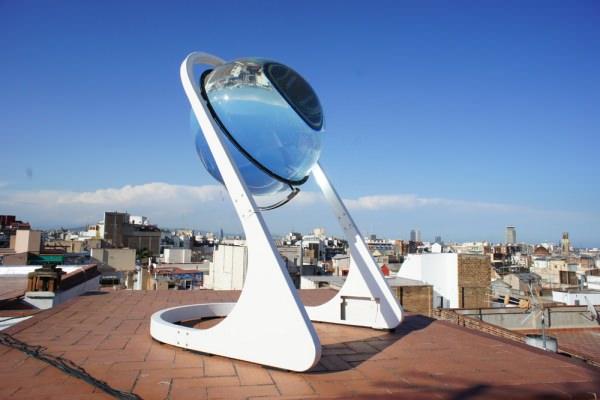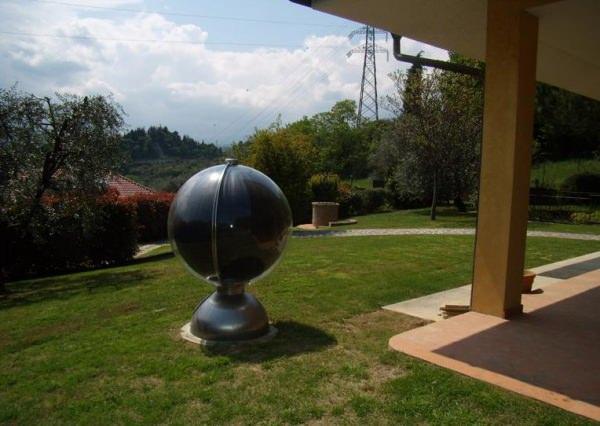Solar Sphere
Post from EditorialsThe latest evolution of solar systems is represented by spherical sensors, that promise greater efficiency in the capture of the sun's rays.
Photovoltaic and solar thermal
Until a few decades ago the possibility of producing energy from the sun was regarded as science fiction.
With the passing of time, also for the need to produce energy from renewable sources, clean technologies of this type have evolved and not only in the presence of photovoltaic panels and solar collectors for hot water production on the roofs of houses that is now widespread, but the costs for their construction and installation are gradually lowering.
When you think of the appearance of the solar panels, in general, one imagines a rectangular structure constituted by silicon modules, in the case of the photovoltaic panels, or glass, in the case of the solar ones.
The latest evolution of the industry is represented by solar collectors instead of spherical shape, which promise greater efficiency in the capture of the sun's rays.
Photovoltaic Solar Sphere
The first system that we illustrate is called Rawlemon and was designed by a German architect André Broessel.
A prototype, subjected to three years of tests and trials, was then installed on the roof of a building in Barcelona, the city where the architect lives.
The idea, as the origin of many inventions, was designed after observing a common phenomenon: Broessel watched his daughter playing with a bag of marbles and noticed how the sun's rays were concentrated on the surface of these. From there, the idea of using this new form to capture the sun's energy.
In this system, instead of the panels there are, therefore, glass spheres rotating, governed by a steel support, which should be more efficient, with a surface area less than that of the modules hitherto used by about 75%.
In fact, the generator spherical concentrates the rays of the sun (but also those of the moon) 10 000 times more than a module level, on a small panel, and thanks to a small sensor follows the movement of the stars. The overall efficiency, therefore, with respect to the systems used so far, should be higher than 35%.
The glass ball, filled with water, is capable of producing even thermal energy, as well as electricity.
Of course, the path to reach a large-scale deployment is still long and tortuous, but for the moment the initial project has already been awarded the World Technology Network Award 2013.
To begin with, the inventor of Rawlemon and his team are keen to produce a version in desktop or laptop, Beta.ey, which could be useful, for example, for charging mobile phones and other small household devices. To do this, they launched a campaign of crowfunding on the site indiegogo.
The overall figure to reach to commercialize patents already filed is $ 120,000.
Solar Thermal Sphere
Meanwhile, a young Italian company based in Candiolo (TO), has already put a ball on the market for solar thermal, capable of producing hot water and home heating.
This device, whose original design dates from the beginning of the new millennium, is called Sferasol and was developed by the company, which owns the patent and know-how, in collaboration with the Politecnico di Torino. 
Even in this case, the operating principle has been developed from the observation of the geometric shape.
It was noted, in fact, that a traditional flat collector is able to capture the sun's rays, according to their angle of incidence. But the sun is low on the horizon, it moves to the south and sets in the west still low. Also on the horizon is higher in summer, lower in winter.
To this is not always possible to capture the same way the rays and in the same quantity.
The spherical shape, however, always shows the same profile from whatever side you look at it.
The collector, which has total area of 4.5 square meters, allows the system to be exposed to sunlight at any time and atmospheric conditions, and captures not only the direct sunlight, but also diffused.
Sferasol is equipped with a system of Plug & Play installation which makes it very easy to put in work, as if it were a common water heater.
The times for the assembly are reduced because you need a simple hydraulic connection with the domestic hot water circuit and an electric motor for the pump.
These components are all contained within the sphere:
- Storage tank with coil;
- Group of pumping fluid heater;
- Electronic control unit;
- Expansion tank;
- Temperature sensors;
- Safety valve.
The sphere has a diameter of 120 cm and is supported by a base of 40 cm in height. Due to its compact size, the device can be placed in various locations within the domestic sphere, and then it can be used, also depending on this, to heat water for sanitary use, to power a plant floor heating or baseboard, or to heat a swimming pool, just to name a few.
There are three versions of the product, the one with tank capacity of 150 liters, the one without storage tank to be integrated with or separate heat exchanger, ideal for swimming pools, and a hybrid version.
80812 REGISTERED USERS










